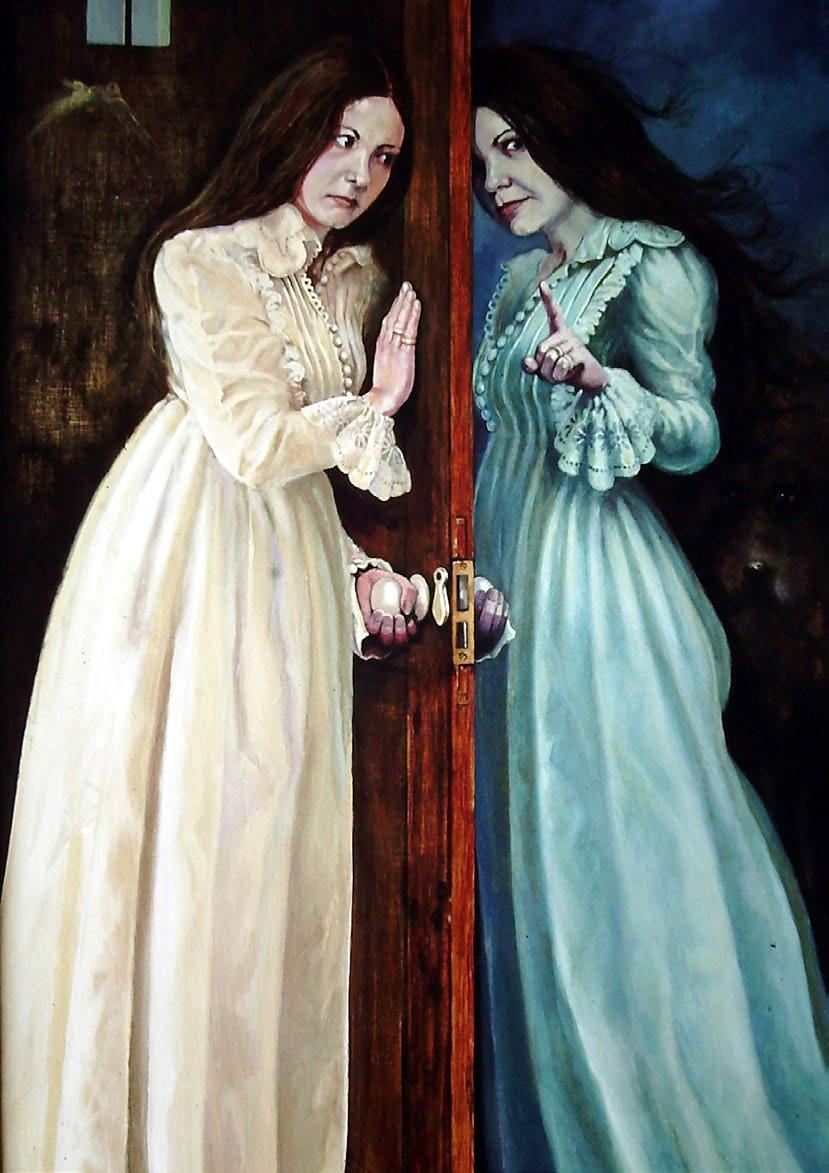
5 minute read
The Baxsters
The Winners
Over 16 - Woman in the Deep by Joseph Watts (Fig. 4) 14 to 16 - Paradise Lost by Sam Bain Up to 13 - Untitled by Naomi Archer
Advertisement
The Runners-up
Over 16 - Shear, Shale & Sea by Sam Day 14 to 16 - The Lakes by Peter Dobson Up to 13 - Plastic Pollution by Poppy Hilton
The LSA is very grateful to the competition sponsors Chrome Yellow Arts, Picturesque Warwick and WH Smith.
Figure 3. Above: Peter Dobson The Lakes
The Baxters, Marvene and Malcolm David Phillips
Marvene and Malcolm Baxter have lived in Leamington Spa since 1972. Both attended Loughborough College of Art as undergraduates and afterwards took on a postgraduate teaching qualification at Leicester University. Marvene started her studies in the sculpture department working in steel, fibreglass and Perspex but later turned to painting. As such, Marvene taught at Campion School as Faculty Co-ordinator for Creative Arts and retiring in 2004. Malcolm similarly taught, being a parttime lecturer in art at Leamington College until his retirement. As married artists, both have contributed to the Leamington art scene professionally for several decades and are well known.
Marvene’s latest painting is the ‘Dress’ (fig. 1), where an Edwardian treasure is presented in its full splendour, complete with shadow, in the corner of a room. It is a glorious still life, demonstrating the consummate skill of the artist, style of the period, nature of the fabric, and intricacies of the design. It takes a moment to digest, but time spent studying the image is rewarding because its stillness and presence is itself a drama which links past and present. Putting the dress on a mannequin seems to have given it a personality and life of its own, which the artist has represented so vividly. It is as if the dress and its shadow create a feeling of a time shift in which the viewer is caught between the early twentieth century and the present. Therefore, this painting has more complexities than might appear at first.
‘Malcolm and Marvene’ (fig. 2), an earlier work, has a different narrative including both artists. Malcolm stares at the viewer belligerently sporting a beard and fez, fist clenched, as if confronting a hostile world. Marvene, dressed in a luxurious silky satin dress, seems equally concerned and agitated as she comforts him. The
Fig. 5 opposite: “Self Portrait with Scissors” by Marvene Baxter, 1981 Pencil on paper, 30 by 22 in Fig. 1: “The Dress” by Marvene Baxter, 1980 Acrylic on canvas, 48 by 36 in
Fig. 2: “Malcolm and Marvene” by Marvene Baxter, 1980
Pencil and watercolour, 30 by 22 in


Figure 4. Above: Joseph Watts Woman in the Deep
Fig. 5: “Full Moon” by Malcolm Baxter, 1976 Oil on canvas, 40 by 32 inches
disconcerting scene is emphasised by a thorny briar crossing her face, as though she bore a jagged knife wound. This is photo-realism at its best, with remarkable versatility. The scene is set in a garden, with a collage-like house looming in the background. These elements of such naturalism could be mistaken as a photograph, the events of which take place in front of our eyes. Its immediacy belies the amazing dexterity involved and adds to the potent emotional surge.
The third work, ‘Self Portrait with Scissors’ (fig 3), is a drawing of a woman jabbing a pair of scissors into the torso of a mannequin. Set in an attic room, the drama is cast in high relief by the light cast from the window. The woman gazes at the viewer, her expression one of disbelief, as if the action is outside of her control. Questions immediately arise as to why such an action should be taking place. This drawing has all the qualities of an enigma and the flavour of an artist like De Chirico. Many different answers arise, stopping us in our tracks and giving the drawing its strength. We look in awe, amazement, and surprise; confounded by the irrationality and puzzled by the action. We also are astonished by the sheer skill of a dramatic incident of this size emerging from a pencil.

Figure 2. Above: Naomi Archer receiving her award
Malcolm’s interests were also widespread: the First World War and Militaria, Steam Engines, Tin-Plate Toys, Lead Figures, Cross Sectional Drawings, the Pre Raphaelites, and Victorian imagery. The obsession which preoccupied his work for many years before his death, however, was the refurbishing of Victorian Houses to their original state. The amount of work was formidable but his determination to achieve his objective was fanatical, and at the expense of his painting in the latter stages of his life. His fascination with Victoriana led him to become a member of Victorian Society, and then representing them on the local Conservation Advisory Forum.
His paintings nevertheless are powerful and evocative, as is the case with ‘Who’s There’ (fig. 4) where the composition revolves around the door acting as a partition between two women. One stands with her pointing finger directed to the viewer admonishingly, perhaps warning the other woman on the other side of the door- but about what we do not know. The woman on the left looks apprehensive, tightly gripping the door handle with one hand whilst the other lays flat on its surface as if to keep the other at bay. They appear as parallel images of one another, wearing the same dress, hairstyle and rings on their fingers. It is a dramatic scene that represents a metaphor of the division between two different versions of the self.
Another beautiful painting is ‘Full Moon’ (fig. 5), which depicts a young woman dressed in a long flowing dress in a woodland glade. She appears spellbound by the starlit sky, staring at the heavens fearlessly. The mood is enhanced by the blue tinge to the image and quality of the ethereal light. Her dog, in contrast, seems fearful, hiding behind her with a snarling expression. Is the dog’s reaction an important warning to her of the hazards, unseen but possible? As with the previous artworks, the mood again is one of uncertainty; there is a hint of danger in what otherwise would seem an enchanting, romantic picture.
This is only a sample of the work of two very talented artists, whose lives were devoted to artistic practice despite having to also earn a living. They both have good exhibition records and have achieved sound reputations as artists in Leamington Spa. Additionally, both Malcolm and Marvene belonged to AMA and LSA, and the now-dissolved ’79 Group. .
Figure 3. Above: Peter Dobson The Lakes











